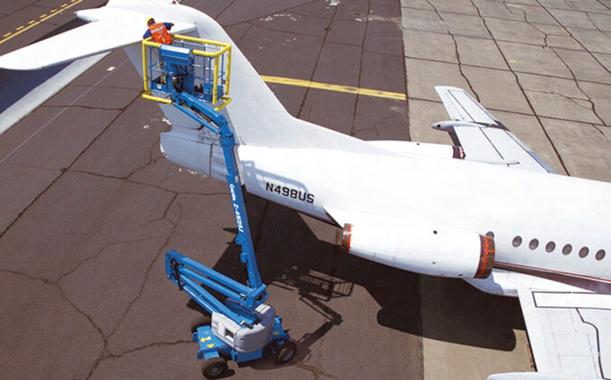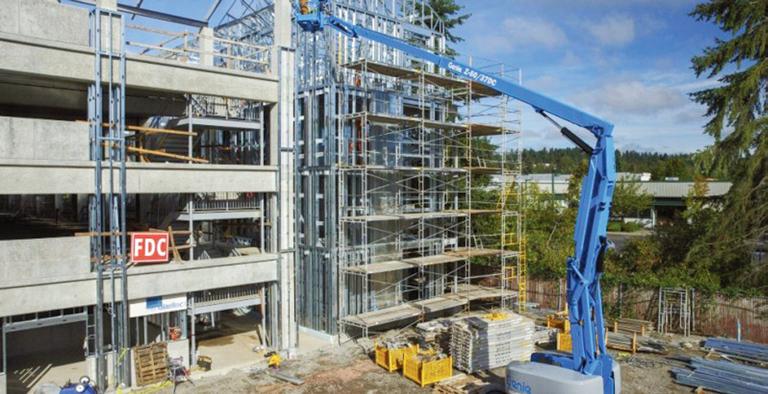
8 minute read
Higher returns
Levelling up on productivity
Working at height using pow ered access and a properly trained operator isn’t just safer than more traditional alternatives, it can bring significant benefits in productivity too. Neil Gerrard reports
Advertisement
How many workers does it take to change a lightbulb? Contrary to what you might expect, this isn’t the prelude to a corny punchline. Instead, it’s key to demonstrating just how much more productive it can be to use powered access equipment than other work-at-height alternatives.
That’s because there is more than one answer to the question depending on the tools you use, as manufacturer Genie demonstrated recently when it undertook an exercise to show why it makes sense to specify a mobile elevating work platform (MEWP) on a jobsite rather than scaffolding. When it came to lighting maintenance work (not necessarily changing a lightbulb but close enough for the sake of our drawn-out analogy), Genie found that it took four people a total of 49 minutes
MEWPs provide flexible and energy-efficient access, saving time and costs
to complete their task. The same task with a MEWP required just two workers, and they were all finished in 20 minutes. This was no fluke. Genie performed a similar test with pillar painting work and found that scaffolding needed the involvement of four workers who took three hours and 32 minutes to complete their task, compared to two workers taking just two hours and 21 minutes on a MEWP. High wall surface cleaning work took four workers three hours and sixminutes, whereas a MEWP saw the job finished by two workers in the significantly faster time of one hour and 43 minutes.
Faster and safer The figures were no surprise to Steve Simmons, joint managing director of Star Platforms, which specialises in low-level platform, scissor lift and cherry picker hire. “As with most access platforms, the low-level access range of machines are safer, faster and more cost efficient than traditional scaffold towers, podium steps and ladders,” he says. “Their compact form means they can get into the tightest of spaces and, being lightweight, they can also be taken into elevators, making them ideal for the construction and maintenance of multi-storey buildings such as office blocks.” Simmons points out that a lowlevel powered access machine is also ready to use immediately as soon as it is in position, whereas a traditional aluminium scaffold tower requires several separate components to be carried into the work area, then erected and dismantled. Even once erected, workers find themselves climbing up and down them repeatedly to complete their task, taking up time, increasing labour and potentially increasing the levels of fatigue workers experience. “With low-level access you simply get into the platform and elevate, which is much more time, cost and energy efficient,” Simmons says. “Lowlevel access is also far safer, minimising the risk of trips and falls compared to climbing towers or using step ladders or podium steps. Also, components of tower scaffolds often get lost or stolen, leading to additional charges for rental customers, which is usually avoided with the use of low-level platforms.”

Replacing scaffolding Nationwide Platforms also points to similar inefficiencies when it comes to solutions such as scaffolding, as well as steps, ladders and alloy towers. Many buildings are now designed to be constructed and maintained to use powered access equipment where there is commercial pressure to reduce project length and cost is a significant factor. Although it isn’t just in construction where they can make a significant difference to productivity – areas such as TV broadcasting and film (see p8), aviation, surveying, sign repair and installation, and industrial maintenance can all benefit too.
↘ The engineer’s part in productivity
↘Belgian company TVH has two main strands to its business – selling parts and equipment for MEWPs and other machines, and a rental department with 4,500 machines in Belgium alone and an estimated 65,000 worldwide.
Those complementary arms give the firm’s co-ordinator of technical trainings Stefan Beke an insight into another way to ensure that powered access equipment is as efficient as it can possible be – maintenance and repair. “IPAF is focused on operator training because we want people to be trained to use this kind of machine and then on the manufacturers’ side of things, they want to make machines that are as dummy-proof as possible,” says Beke. “But safety features can only operate correctly if they are checked, maintained and calibrated properly.” Nonetheless TVH noticed that when it sent engineers out to undertake repairs, dispatchers tended

to look geographically for the closest person. That resulted in a fair bit of rework, with the first engineer to visit often not being familiar with the machine in question. This has led TVH to change its training, shifting from “open” theoreticalbased training to much more practical training ending in theoretical and practical tests, combined with a new competency matrix of engineers to make sure that the right person has been sent to the right job.
Meanwhile, clever use of technology also plays a part. TVH uses GPS trackers not just to keep an eye on its machines’ locations but also to monitor running hours of the engine or pump hours if it is an electric machine.
“We can avoid downtime with pre-hire and posthire inspections and with the GPS we can see how much a machine has been operated and if maintenance is due we can endure that machine doesn’t go out on hire,” Beke adds.
Genie’s Z60/37DC articulated boom lift in action

↘ Work at height case studies
Scissor lift Scaffolding Workers Time to complete Workers Time to complete
High wall surface cleaning work 1-2 1 hr 43 mins 4 3 hrs 6 mins Pillar painting work 1-2 2 hrs 21 mins 4 3 hrs 32 mins Lighting maintenance work 1-2 20 mins 4 49 mins
Nationwide recently developed a ‘proof of concept’ to replace traditional scaffolding with its selection of powered access equipment in conjunction with Balfour Beatty. National Grid undertook a site survey on a 15-storey building and found that various riser pipes needed to be replaced urgently. Normally, the project would have involved the use of scaffolding around the building but instead site manager Terence Mahoney chose a 70m truck mount supplied by Nationwide Platforms to perform the work.
The result, Mahoney says, was a £60,000 saving. “Plus it removed the need for fixed scaffolding, which would have caused damage to the building,” he adds. “Essentially, using powered access helps us get the job done safely and quickly.” The test led to powered access being used on a further 16 National Grid projects last year.
Contractor ISG, which specialises in building fitouts, has also undergone Source: Genie
its own conversion to the efficiency of powered access. It undertook a study on a project where it used traditional access equipment on one floor, and Pecolift low-level access platforms with a reach of up to 4.2m on another. The secure platform permits working in a full 360-degree range, while keeping both hands free. ISG discovered that the machines, although more expensive, were 20% faster and boosted productivity.
The importance of good training IPAF’s training manager Paul Roddis, who previously worked as a training manager at HSS, has seen first-hand how much more labourintensive scaffold towers can be as opposed to powered access.
“If you want to use an aluminium scaffold tower, it requires two people to build it and they have a maximum freestanding height of about 10m. Then if you want to move
∕∕ Essentially, using powered access helps us get the job done safely and quickly Terence Mahoney, Balfour Beatty it, you require two people to reduce its height, move it, and then put it together again. Plus platform heights can only be set at certain levels, whereas powered access is infinitely variable. So powered access is much quicker,” he explains.
But the capabilities of the machines themselves shouldn’t be viewed in isolation, Roddis stresses. Core to using powered access productively – and above all safely – is ensuring that the operator is capable, and that’s where good training is key. IPAF’s standard operator training course conforms with ISO 18878 and beyond that there is its IPAF PAL+ course for advanced operators.
“IPAF PAL+ is designed for people who are working in more challenging and potentially more hazardous environments. Once people have practised and achieved what they need to achieve to pass this training, it makes them far more productive and far less likely to potentially collide with anything or put themselves at risk. It puts them in exactly the right position they need to be in in order to be able to work properly and get the most effective use out of what is the most efficient machine,” he says.
There are interesting changes on the horizon that promise even greater productivity too. The manufacturing standard for MEWPs in Europe, EN 280, will soon see the introduction of a part 2 that deals with lifting devices. Potentially, this means that materials can be lifted using a powered access machine equipped with a lifting tool, as opposed to employing a second device to do this, as is currently the case.
Back to the setup for our non-joke about changing a lightbulb, perhaps the question should be “Howmany trained workers does it take?” Provided they are using powered access the punchline is thatitneed take only one.











